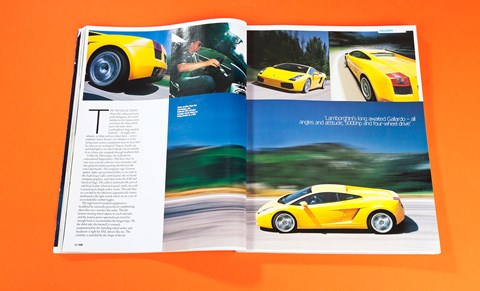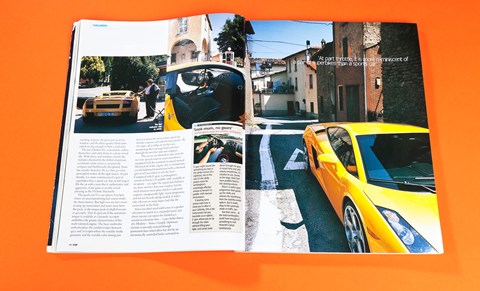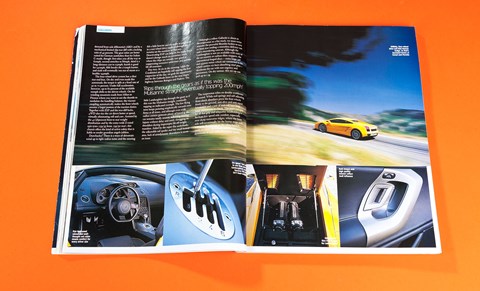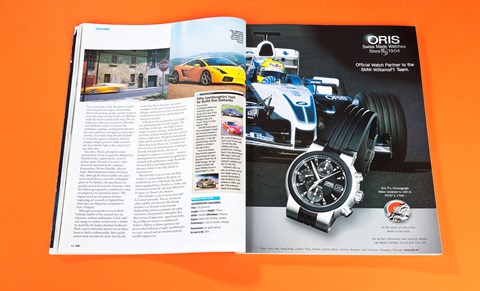The metallic paint shines like a thousand suns: giallo bolognese, the visual antidote to the famous rosso corsa from the other end of town. On looks alone Lamborghini’s long awaited Gallardo — all angles and attitude, 500bhp and four-wheel drive — serves emphatic notice Ferrari’s 360 Modena is at last facing some serious competition from its local rival. So what are we waiting for? Hop in, buckle up, and hold tight as we take Gallardo chassis number 18 on a three-day stampede through northern Italy.
Unlike the Murcielago, the Gallardo has conventional hinged doors. Pull them shut, let your eyes scan the cabin for a few moments, and take good aim before pushing the belt into the concealed buckle. The imaginary sign ‘German spoken’ lights up your frontal lobes as you take in the Audi-esque radio control panel, the on-board computer graphics, and safety items like ESP and lateral air bags. The cabin is trimmed with acres of soft black leather which feels good, smells nice and is jazzed up by bright yellow seams. The only flaw we can find in the otherwise ergonomically correct dashboard is the light switch which sits in a row of seven lookalike control toggles.
The high level of standard equipment is headlined by unusually powerful air conditioning, sheer bliss on a scorcher like today. The flat-bottom steering wheel adjusts in reach and rake, and the narrow power operated seats travel far enough back to accommodate the longest legs. On the debit side, the footwell is seriously compromised by the intruding wheel arches and headroom is tight for XXL drivers like me. The visibility is curtailed by the shape of the far-reaching A-posts, the postcard sized rear window, and the three-quarter blind spots which are big enough to hide a road train.
The ten cylinders fire, concentrate, collect themselves and settle down to a deep voiced idle. With doors and windows closed, the melodies directed by the drilled aluminium accelerator come across as acoustically compact and rhythmically disciplined. From the outside, however, the 5.0-litre 40-valve powerplant makes all the right noises. At part throttle, it is more reminiscent of a pair of superbikes than a sports car, but on full song it fills the air with a tune that is authoritative and aggressive, if not quite as overtly crowd pleasing as the V8 from Maranello.

The quad cam V10 can spin to 8050rpm where an uncompromising fuel cutout marks the finale furioso. But high revs are not a must to keep up momentum and zoom away from the pack, as the torque peak of 369lb ft occurs at 4500rpm. That 80 percent of the maximum torque is available at a leisurely 1500rpm underlines the grunty characteristics of this multi-talented engine. The busy multivalve orchestra plays the catchiest tunes between 3500 and 7000rpm where the variable intake geometry and the variable valve timing join forces to boost the twist action, speed up throttle response and unleash more power. By 7800rpm, all 500bhp are on the case, trumpeting their message loud and clear through the two five-into-one tailpipes.
The car we are allowed to take away for our very special coast-to-coast marathon is equipped with the standard six-speed manual. Mounted aft of the engine, this is a brand new, yet old fashioned transmission with a chromed gate to tell you where to slot the lever. Compared with E-gear,(Lamborghini’s version of Ferrari’s F1 paddle-shift, available as an option — see right) the speed and slickness are more mid-8os than new century, but the small diameter twin-plate clutch is a pleasant surprise: unexpectedly light, nicely progressive and not too heavily spring-loaded, it makes take-off even on steep slopes look like the easiest trick in the book.
Since you don’t need sixth sense or a pocket calculator to match revs and pedal travel, just about anyone can repeat the claimed 4.2 second acceleration time — 0.3sec better than a 360 Modena — from 0-62mph. Optimum traction is not only ensured through permanent four-wheel drive but also by an electronically controlled brake-activated on demand front axle differential (ABD) and by a mechanical limited slip rear diff with a locking ratio of 45 percent. The gear ratios are better suited for German autobahns than for Italian C-roads, though: first takes you all the way to 62mph, second stretches to 86mph, third is a long-distance cast to 113mph, fourth is good for 140mph, fifth breaks the 170mph barrier, and sixth will eventually run out of steam at a healthy 193mph.
The four-wheel drive system has a clear rear end bias. On dry and even roads like autostrada, the torque is split at a fixed rate of 30 to 70 percent. Under full acceleration, however, up to 80 percent of the available oomph shifts to the driven wheels. On the winding mountain roads from Milan to Firenze where you want to use the throttle to modulate the handling balance, the viscous coupling automatically makes the front wheels assume a larger portion of the traction duties. Together with ESP and the two diff locks, 4WD also ties the car down better at speed, virtually eliminating roll and yaw. Assisted by the 42/58percent front to rear weight distribution and by the extra-wide Z-rated 1.9in tyres (235/35 front, 295/30 rear), this chassis offers the kind of active safety that is liable to render guardian angels jobless.

Drawbacks? There is a trace of drivetrain wind up in tight radius turns and the steering felt a little heavier and not quite as carefree as in a rear wheel drive supercar through the twisties on the outskirts of Tuscany. Deactivating ESP can help on the track, but it doesn’t change much on secondary roads, where the chips are actually very good at suppressing excessive understeer and sudden lift off oversteer.
Day two. At six in the morning, while the Carabinieri are hopefully still sipping the first cappucino of the day, we grab the opportunity and let the Gallardo loose on the near empty highway between Bologna and Padova. The little Lamborghini rips through the gears as if this was the Mulsanne straight, eventually topping an indicated 200mph. The low flying nose keeps pointing emphatically towards terra firma at all times, and although even wide radius corners generate plenty of lateral g, the car remains totally neutral, following steering inputs without delay and rarely shrugging shoulders during impromptu lift off weight transfers. Aided by the super-flat underbody, the adjustable tail spoiler and the small front area, lack of aerodynamic downforce is never an issue.
Although a yellow Gallardo is about as inconspicuous as a fire truck, we must twice monster the powerful Brembo brakes to save us from rear-ending a mirrorless delivery van and a meandering caravan. Although the Lamborghini is not yet available with state of the art ceramic or carbon-fibre stoppers, the conventional forged discs — extra 356 and 335mm rotors which are connected to the wheel carriers via heat-absorbing steel pins —decelerate the car with rare urgency and persistence. On dry tarmac, this set-up can pull up to 1.1g.
The suspension relies on double wishbones all-round. While coil springs and self adjusting Koni shock absorbers press the four wheels firmly to the ground, anti-dive and anti-squat kinematics and a pair of anti-roll bars keep body movements in check. The price you pay for all that grip and telepathic roadholding is ho-hum low speedride comfort, especially over sharp transverse ridges, where the front axle will occasionally hit the bump stops with a crunch. Tramlining on the other hand is rarely an issue: directional stability does not deteriorate in sync with the surface quality.
At 2.3 turns lock to lock, the power assisted rack and pinion steering is commendably direct without being snappy, and the weight in your palms does not alter much, even through snake-like bends tackled at full song. This car simply goes wherever you point it, efficiently and effortlessly, totally sure footed and confidence inspiring, avoiding both defensive pre-apex understeer and aggressive post-apex oversteer. It certainly helps that the Gallardo is, at least by supercar standards, relatively compact (length 4300mm, width 1900mm) and also relatively light in this context (just 1430 kilos, dry).

Day three. This Lamborghini is truly cosmopolitan. It was designed by Belgian Luc Donckerwolke, engineered by a team of Italians under Massimo Ceccarani, and is about to be launched by the company’s German boss, Werner Mischke, who ran Audi’s R&D department before moving to Italy. Although the final assembly takes place in the refurbished 40 year-old Lamborghini plant on Via Modena, the spaceframes are prefabricated in Neckarsulm, Germany, where the Volkswagen group has established a center of competence for aluminium bodies. The engines travel an even greater distance, originating at Cosworth in England from where they are shipped for completion to Gyor, Hungary.
Although not yet perfect in every detail, Gallardo number 18 has covered over 750 kilometres without malfunction. It feels solid and strong, its cutlines would satisfy a stickler for detail like the former chairman Ferdinand Piech, and its full leather interior was an object lesson in Italian craftsmanship. Strict quality control made sure that the doors shut like the vault of the Banca Populare, the xenon headlights lit the road and not the skies over Bologna and that the excellent sound system would always match the superb engine for aural goose pimples.
Gallardo owners are forced to travel light —just ask photographer Charlie Magee. The small boot in the nose cone holds at best a couple of square soft bags, and behind the seats there is barely enough space for a pair of jackets or light coats. Wedged in between the cabin and the firewall is the 90-litre fuel tank which begs to be filled every 200 miles or so. Over an even mix of fast freeways, fourth-gear B-roads and tight twisties, the test car averaged 10.4mpg or 27.0 l/100km — which is unexceptional but nonetheless acceptable for a seriously high-performance coupe that needs no more than a small adjustment in tyre pressures before it can safely double as weekend racer.
Priced keenly at 139,200 euro, the baby Lambo is a serious threat to the sports car establishment. It is a little dearer but much better equipped than a Porsche 911 Turbo, and it is bound to make life a lot more difficult for its target car, Ferrari’s 360 Modena.
The Gallardo’s secret of success may well be its dual nationality. You see, in terms of safety, solidity and structure, this driving machine is as Teutonic as the German shepherd dog which accompanies the night-watchman at Automobili Lamborghini SpA. But in terms of appearance, appeal and ability, the 500bhp two-seater is as emphatically Italian as Milano vs Roma, paparazzi and pizza or the Colloseum at night. Just think of it as a sexy, sensual and yet somehow perfectly sensible supercar.
The specs
Price: 139,200 euros
Length/width: 4300/1900mm
Wheelbase: 2560mm
Engine: 4961cc V10, 500bhp, 369lb/ft
Performance: 4.2sec 0-62mph, 193mph
Transmission: Six-speed manual
On sale in UK: 2004
